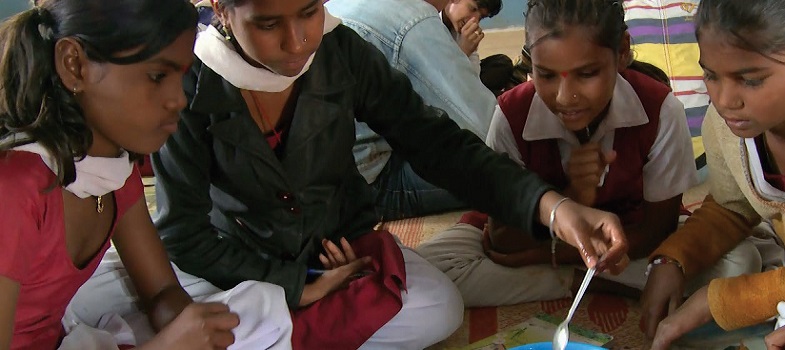Resource 2: Two English language games
You can encourage active listening in English with your students, and prompt them to respond to the English that you use. You can observe how much students understand what you say. Students can also learn by observing their peers. In games, you can use home languages as well as English, to encourage participation.
‘Do What I Say’
The teacher gives instructions orally and the students must listen and do the actions.
Start with simple instructions.
As students make progress, make the game more advanced. You can also adapt the game to different topics.
- ‘Touch your nose.’
- ‘Touch your partner’s back.’
- ‘Hold up five fingers.’
- ‘Point to someone who has long hair.’
- ‘Put your pencil on the floor.’
- ‘Put your pencil under the chair.’
- ‘If you like mangoes, clap your hands.’
- ‘If you don’t like bananas, make a face.’
- ‘If Delhi is capital of India, put up your hands.’
- ‘If plants grow with the help of sunlight, nod your head.’
Some students would copy others, of course, but the point of the game is that everyone is hearing and responding to English. As students do this, they can learn vocabulary for physical descriptions, for positions, likes and dislikes, language for specific subjects, and language for general knowledge.
When you try out this kind of activity in your classroom, make sure that you choose actions and situations appropriate for the students and their level of knowledge. You may demonstrate the actions linked to the English, especially when these are new words, or when the students are having difficulty. Give the students time to listen and respond. They do not need to produce any English – they must only show that they understand you. You and the students can mix English and home languages in the game, to encourage participation.
‘Guess Who’
Divide the class into two groups. Group 1 has to secretly think of a thing or a person; Group 2 has to ask questions to guess who or what is it. Group 1 can only answer only ‘yes’ or ‘no’. As the teacher you must help Group 2 to ask their questions. Prepare for the game in the following way:
Think of six things and people that Group 1 can choose as their secret – these can be familiar to the students, such as a chair, a table, a spoon, a tiffin box, a water bottle or a book. For people, think of professions like postman, driver, cook, teacher, doctor, nurse or policeman/woman. Then think of all the words that could be used to describe these things and people. Next, think of how questions could be asked using these words.
Let Group 1 choose one of the six things or people as their secret. Remind the students in Group 1 that women as well as men can be found in all the occupations. Here are some examples:
- For people (postman, driver, cook, teacher, doctor, nurse or policeman/woman):
- ‘Is it a man or a woman?’
- ‘Does the person wear a uniform?’
- ‘Is the uniform white?’
- ‘Does the person use chalk/a stethoscope/a thermometer/a bicycle?’
- ‘Does the person work in a hospital/school/kitchen/police station?’
- For things (a chair, a table, a spoon, a tiffin box, a water bottle, and a book):
- Size words: ‘Is it big? Is it small?’
- Shape words: ‘Is it round? Is it square? Is it long?’
- Colour words: ‘Is it white? Is it black? Is it coloured?’
- Material words: ‘Is it made of plastic/paper/wood/leather/steel?’
- Used-for words: ‘Is it used for writing/reading/cutting/keeping things?’
- Location words: ‘Is it here in your bag/in this room/in school/in every house?’
Before you play the game in class, most importantly, make time for yourself to practise the words in English. If possible, play ‘Guess Who’ with a fellow teacher, as a partner.
Resources
